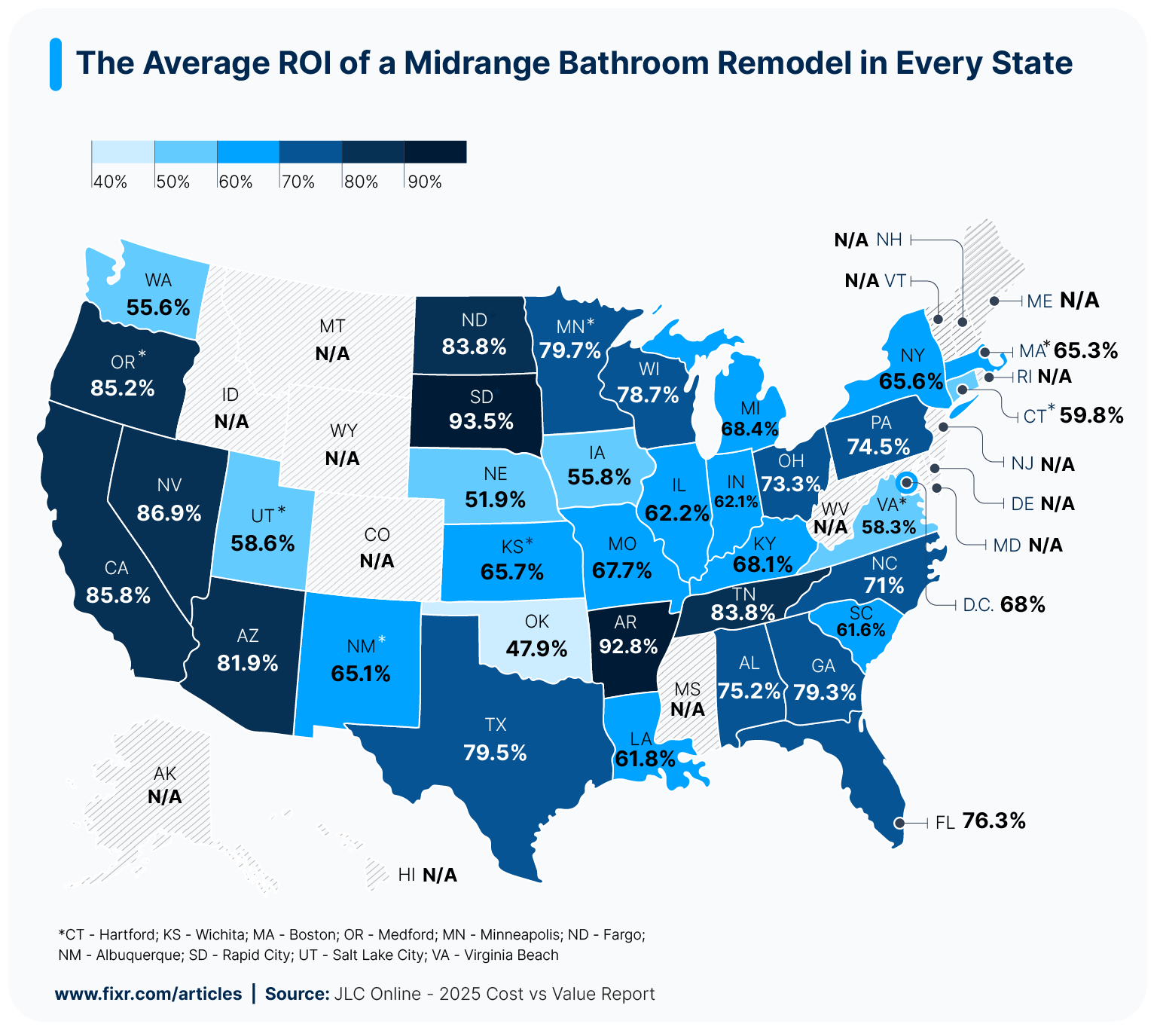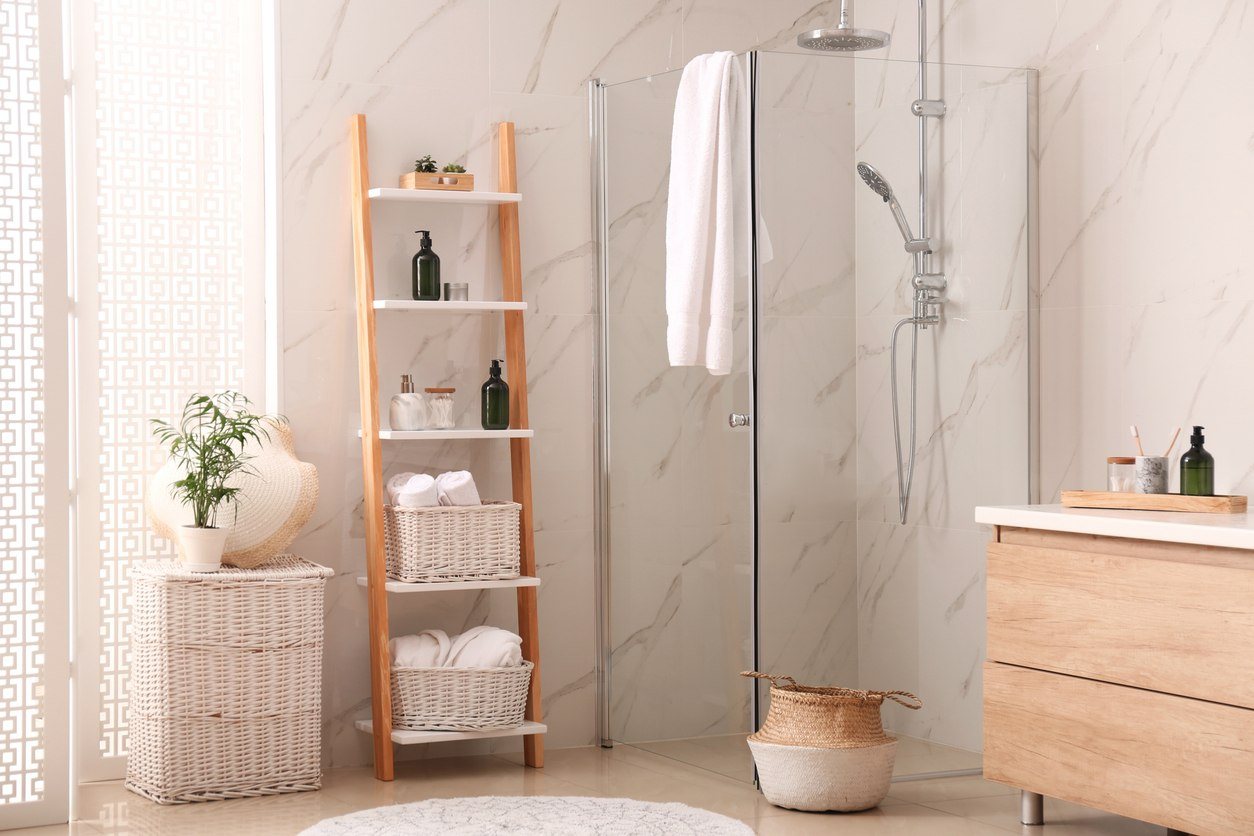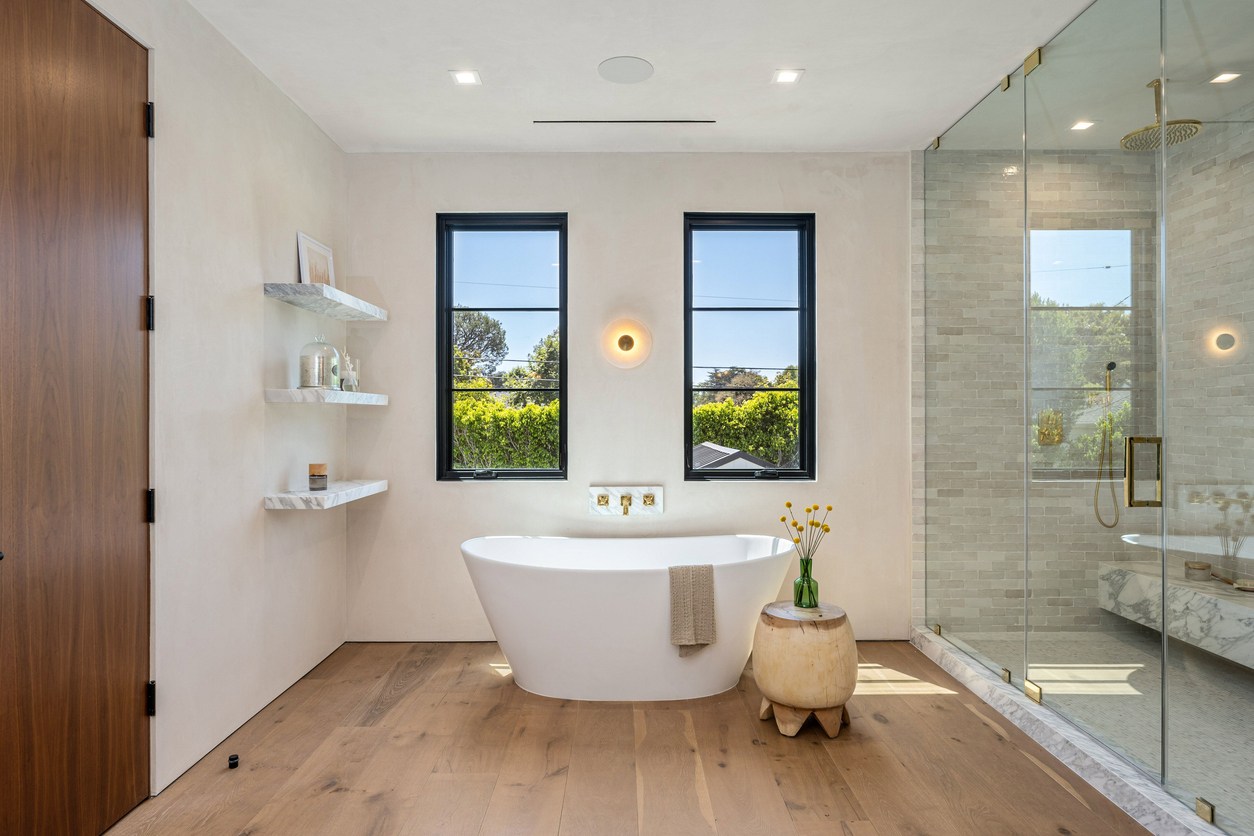Your home is your castle, and the place you return to each day. So it makes sense that you want your home to reflect how you feel about it, and this may mean needing a home improvement project from time to time. Along with kitchens, bathrooms have remained one of the most popular spaces of the home to remodel over the last few years. Bathrooms get a lot of use and need to be highly functional spaces to meet the user’s needs, therefore when a bathroom isn’t at its best, it gets moved to the top of the list for remodeling quickly.
If you're planning to sell, an attractive, recently updated bathroom can boost your home's resale value and appeal to potential buyers, helping it sell more quickly. Below, we’ll break down what makes a good ROI for bathrooms, as well as which states are best for getting the maximum ROI from this project.
Quick Summary: Key Takeaways on Bathroom Remodel ROI
Across the U.S., a midrange bathroom remodel has an 80% return on investment (ROI) in 2025, the highest it's been since 2007. This is a 6.3% increase from last year's 73.7%, showing that buyers are willing to pay a premium for updated, move-in-ready bathrooms. Certain states outperform the national average by a wide margin. South Dakota leads the list, with homeowners recouping 93.5% of remodeling costs at resale, followed closely by Arkansas, Nevada, California, Oregon, and North Dakota. This high ROI shows that buyers across the states are willing to pay a premium for updated, move-in-ready bathrooms in 2025.
ROI on Bathroom Remodel by State
Return on investment (ROI) is the percentage of money you will get back from a project at the time of resale. If you invest $5,000 in a bathroom remodel, and the value of your home goes up by $3,000, then this project has an ROI of 60%. The higher the return on investment, the more money you’ll receive back from the project at the time you sell your home. Keep in mind, though, that ROI can drop over time, so it’s best to remodel with resale or ROI in mind if you plan on selling your home in the near future. Most homeowners see the biggest ROI from mid-range remodels, rather than minor cosmetic updates or very high-end remodels. However, ROI can also depend on where you live, with different states having different percentages.

Top 10 States With the Highest Bathroom Remodel Return on Investment
The table below highlights the top 10 states with the highest bathroom remodel ROI in 2025, followed by a breakdown of what’s driving returns in each location.
While the national average ROI for a midrange bathroom remodel in 2025 is 80%, several states outperform that figure by a wide margin. South Dakota tops the list this year, with homeowners recouping 93.5% of their renovation costs at resale. Close behind is Arkansas, where a typical bathroom remodel brings back 92.8% of its cost. This high ROI suggests that homebuyers in the state are willing to pay more for updated, move-in-ready homes. In Nevada, homeowners can expect an 86.85% return. Similarly, California comes in at 85.8%, where sustainable updates such as water-saving fixtures and modern ventilation systems remain major selling points amid ongoing drought concerns.
Oregon ranks just behind with an ROI of 85.2%, and North Dakota follows at 83.8%, showing that functional and durable remodels are key even in smaller markets.
Tennessee averages 83.76%, with consistent buyer demand for clean, updated bathrooms that don’t require post-purchase renovations. Rounding out the list are Arizona which sits at 81.9%, Minnesota with an ROI of 79.7% and Texas at 79.46%
Since October 1, 2025, a 50% tariff applies to imported bathroom vanities. Higher prices could increase overall remodel costs, making it harder for homeowners to recoup their investment at resale.
Which Bathroom Upgrades Add the Most Value?
Not all bathroom remodels are created equally. If you want to maximize your ROI no matter what state you live in, you may want to focus on specific projects, materials, and parts of the bathroom when updating. Mid-range remodels involve replacing all fixtures and surfaces without altering the room’s layout or size. The key is using materials that are of moderate to good quality, rather than builder-grade or luxury. These remodels may fix minor plumbing issues, leaks, or mold problems, so it can improve the function of the room as well as its appearance.
Fixr.com estimates that the average bathroom remodel costs between $6,000 and $18,000. Below, we’ve listed some projects with strong ROI potential, along with their national average cost ranges, so you can choose the projects that best align with your goals and maximize your return.
Modern Fixtures
 Updating your bathroom fixtures is one of the simplest yet most effective ways to give the space a fresh, modern look. Sleek faucets, streamlined showerheads, and modern hardware can instantly elevate the overall design and make even older bathrooms feel new again. Black matte, brass, and chrome finishes remain especially popular in 2025, offering timeless appeal that complements a wide range of styles.
Updating your bathroom fixtures is one of the simplest yet most effective ways to give the space a fresh, modern look. Sleek faucets, streamlined showerheads, and modern hardware can instantly elevate the overall design and make even older bathrooms feel new again. Black matte, brass, and chrome finishes remain especially popular in 2025, offering timeless appeal that complements a wide range of styles.
Beyond aesthetics, modern fixtures often improve functionality and efficiency. Many new models feature energy-efficient, water-saving technology and temperature control options, helping homeowners reduce utility costs while enhancing everyday comfort. Swapping out outdated fixtures is also a quick project that doesn’t require a full remodel, making it ideal for smaller upgrades or budget-conscious renovations.
National Average Cost Range: $1,200 - $3,600
Average ROI: 85%
Double Vanity
 There are many ways to elevate the bathroom sink area, but double vanities are by far the most popular option among today’s homeowners. They offer a luxurious feel, extra storage, and added functionality, making busy mornings more manageable for couples or families who share a space. Double vanities also hide plumbing, provide ample counter space, and keep essentials neatly organized and out of sight.
There are many ways to elevate the bathroom sink area, but double vanities are by far the most popular option among today’s homeowners. They offer a luxurious feel, extra storage, and added functionality, making busy mornings more manageable for couples or families who share a space. Double vanities also hide plumbing, provide ample counter space, and keep essentials neatly organized and out of sight.
Since vanities require countertops, the total cost can vary significantly depending on the material and design. If you’re remodeling the entire bathroom, plan to spend around 25% of your total renovation budget on the vanity area.
National Average Cost Range (Vanity and Shelving): $1,500 - $4,500
Average ROI: 80%
Updated Lighting
 Light fixtures is an important part of any room’s design, and even more so in the bathroom. Most bathrooms do not get natural light, and those that do don’t tend to get a lot of it. So good lighting is crucial to the room’s appearance and function. Every bathroom ideally needs some layered lighting. This includes the ambient lighting that is one of the best ways to create a spa-like feel in your bathroom, according to 46% of experts, task lighting such as lights at the vanity or in the shower, and accent lights that can help light up specific areas.
Light fixtures is an important part of any room’s design, and even more so in the bathroom. Most bathrooms do not get natural light, and those that do don’t tend to get a lot of it. So good lighting is crucial to the room’s appearance and function. Every bathroom ideally needs some layered lighting. This includes the ambient lighting that is one of the best ways to create a spa-like feel in your bathroom, according to 46% of experts, task lighting such as lights at the vanity or in the shower, and accent lights that can help light up specific areas.
Lights don’t need to be expensive to enhance the room, so they’re a good choice for any bathroom update. If the bathroom is small or dark, lighting becomes even more important to the space, and can help make it much more visually appealing, increasing not only the ROI of the whole project, but also the number of interested parties.
National Average Cost Range: $50 - $250/each
Average ROI: 80%
Walk-In Shower
 Walk-in showers are quickly becoming the new must-have in modern bathrooms, with 45% of interior design experts naming them the most popular shower design for 2025. Homeowners are gravitating toward these sleek, open designs for their easy maintenance, accessibility, and spa-like appeal. Frameless glass enclosures, rainfall showerheads, and built-in benches or niches are especially impactful, creating a clean and luxurious feel.
Walk-in showers are quickly becoming the new must-have in modern bathrooms, with 45% of interior design experts naming them the most popular shower design for 2025. Homeowners are gravitating toward these sleek, open designs for their easy maintenance, accessibility, and spa-like appeal. Frameless glass enclosures, rainfall showerheads, and built-in benches or niches are especially impactful, creating a clean and luxurious feel.
If your existing shower is outdated, has mold or cracked tile, or feels closed in, a walk-in shower upgrade can completely transform the space and make it look brighter and more modern.
National Average Cost Range: $5,000 - $11,000
Average ROI: 70%
Updated Flooring
 Updating the flooring of your bathroom is a good way to increase your ROI. The floor of any bathroom can take a beating, seeing not only foot traffic, but also a lot of water, moisture, and potential spills of things that can be abrasive or acidic. This means that older floors can bring the whole room down, with stained and discolored grout, stained and etched tiles, or even mold and mildew growth beneath the floor from leaks and high humidity.
Updating the flooring of your bathroom is a good way to increase your ROI. The floor of any bathroom can take a beating, seeing not only foot traffic, but also a lot of water, moisture, and potential spills of things that can be abrasive or acidic. This means that older floors can bring the whole room down, with stained and discolored grout, stained and etched tiles, or even mold and mildew growth beneath the floor from leaks and high humidity.
Porcelain tile and luxury vinyl remain the most popular choices thanks to their durability, water resistance, and low maintenance. For homeowners looking to add a modern, spa-like feel, heated floors are an increasingly desirable upgrade. They provide steady warmth underfoot, eliminate the chill of tile on cold mornings, and contribute to a sense of everyday luxury that buyers notice.
National Average Cost Range (Heated Floors): $5,000 - $11,000
Average ROI: 65%
How to Get the Best ROI on Your Bathroom Remodel: A Step-by-Step Guide
Not all bathroom remodels are the same; some things are going to get you a better ROI than others, regardless of whether you update the entire space or just parts of it. Here are some steps you can take to enhance the ROI of your bathroom remodel:
1. Repair First, Remodel Second: Before any cosmetic upgrades, fix what's broken. Address any leaks, water damage, or mold issues. These things can lower your property value, so fixing them is crucial to any good resale cost.
2. Focus on a Functional Design: Choose a layout and features that are easy to use and appeal to a broad range of buyers. Avoid overly personal or niche design choices that might not have wide appeal.
3. Get Multiple Quotes: Shop around and get the best price on everything from the materials to the professionals you hire for the job. Don't be afraid to get quotes from at least three different contractors.
4. Do Some Work Yourself (If You Can): You can save a significant amount of money by handling tasks like demolition, painting, or minor repairs yourself.
5. Aim for Quality, Not Luxury: Avoid very high-end or custom features, as they rarely provide a dollar-for-dollar return. Stick with good-quality, widely available materials.
6. Match Your Neighborhood's Standard: Research what buyers in your area expect. A real estate agent can offer valuable insight. Your bathroom should be in line with comparable homes in your neighborhood to maximize its value.
Methodology
We analyzed midrange bathroom remodel return on investment (ROI) data by city using the 2025 Cost vs Value Report from JLC Online. For each state, we calculated the average return on investment across all the available cities to determine the state average. We then compared the state averages to identify where bathroom remodeling pays off the most.
Note: ROI data wasn’t available for cities in Idaho, Alaska, Colorado, Delaware, Hawaii, Maryland, Mississippi, Montana, New Hampshire, New Jersey, Rhode Island, Vermont, West Virginia, Wyoming, and Maine, so these states were excluded from our analyses.
FAQ: Bathroom Remodel ROI
Yes! A bathroom remodel is considered a strong investment for homeowners, delivering 80% ROI. Midrange updates, such as modern vanities, walk-in showers, or updated lighting and fixtures, can deliver an average ROI of 70–85%, making a bathroom remodel truly worth it for both resale value and everyday comfort.
Investing $25,000 in a midrange bathroom remodel could add approximately $20,000 to your home’s value, reflecting an 80% return on investment.
$10,000 is enough for a midrange bathroom remodel. This budget can cover updates such as a new vanity (single or double), walk-in shower or tub/shower combo, modern fixtures, lighting upgrades, and refreshed flooring or tile. Costs can vary depending on material choices and labor rates in your area.
A realistic budget for a bathroom remodel in 2025 depends on the scope and size of the project:
Minor remodel: $2,400 - $10,000 (cosmetic updates like fixtures and paint)
Partial remodel: $6,000 - $25,000 (new tub/shower, vanity, plumbing updates)
Full remodel: $9,000 - $30,000+ (layout changes, flooring, tiling, high-end finishes)
Irena is an industry analyst and content specialist at Fixr.com, SolarReviews, and Howmuch.net, where she transforms complex data into clear insights that help readers make smarter financial decisions. She holds a degree in Economics and has been conducting personal finance research since 2018, bringing a strong analytical foundation to her work. Her insights have been featured in reputable outlets such as the Washington Examiner, Yahoo Finance, Fox40, and Forbes.
